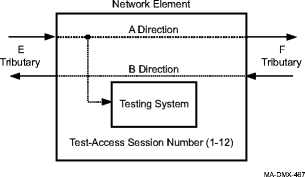Procedure 14-30: Establish internal test access session in the MONE mode
 Overview
Overview
Important!
The network element must be equipped with Very Large Fabric (VLF) circuit packs in the Main slots to support internal test access sessions.
Use this procedure to establish a new internal test access session in the MONE test access mode.
To establish a new external test access session in the MON(E or EF) mode, refer to Procedure 14-22: Establish external test access session in the MON(E or EF) mode.
A new internal test access session can be created only in the MONE test access mode initially. To change the test access mode of an existing internal test access session, refer to Procedure 14-32: Change test access mode of internal test access session.
Important!
The Tributary Maintenance parameter for the affected connected tributaries must be provisioned Allow to perform this procedure. If the Tributary Maintenance parameter for the affected connected tributaries is provisioned to Inhibit, test access commands for the affected ports are denied. Unconnected tributaries are always available for test access.
To view the Tributary Maintenance parameter, a Privileged, General, Maintenance, or Reports Only user must select Administration → Allow/Inhibit Tributary Maintenance to access the required tributary.
To provision the Tributary Maintenance parameter, a Privileged user must perform Procedure 7-23: Allow/inhibit port/tributary maintenance.
 Privilege level
Privilege level
You must log in as either a Privileged, General, or Maintenance user to complete this procedure.
MONE mode
The MONE mode is used to monitor the E Tributary input signal of a one-way cross-connection, a two-way cross-connection, or an idle E Tributary input signal (no cross-connection).
The following figure shows an example of the MONE mode used to monitor the E Tributary input signal of a two-way cross-connection.

If the F Tributary is entered, the F Tributary must be the destination of a one-way cross-connection that has the E Tributary as the source, or the F Tributary must be part of a two-way cross-connection that does not have any other test access sessions on it. If the E Tributary is part of a two-way multicast cross-connection, entering the F Tributary is optional. The system automatically retrieves the other end. The E Tributary or F Tributary cannot be on a DS1, DS3, TMUX, or Ethernet/Data circuit pack.
Restrictions
The following restrictions apply when establishing an internal test access session in the MONE mode.
-
A new internal test access session can be created only in the MONE test access mode initially.
-
A new test access session is denied if a node or ring network upgrade is active (node is in provisioned Ring Upgrade mode).
-
A new test access session is denied if a transmission test, loopback, or test access session is already active on an affected port.
-
Test Access of UPSR Dual Ring Interworking cross-connections is not supported.
-
The network element must be equipped with Very Large Fabric (VLF) circuit packs in the Main slots to support internal test access sessions.
-
Up to 12 simultaneous test access sessions are supported, regardless of the test access rate and type (external or internal).
-
On LNW20 48TMUXDS3EC1 circuit packs, only DS3 Ported/Unchan and EC1 ports may be used for the E Tributary and F Tributary.
|
NOTICE Service-disruption hazard |
Service interruptions may occur on unintended tributaries if unsupported test access configurations are attempted.
Recheck the address (AID) of the tributary(ies) being tested. Do not attempt to establish unsupported test access sessions.
 Before you begin
Before you begin
Prior to performing this procedure:
-
Refer to Before you begin and Required equipment in this chapter.
-
Refer to Laser safety and Electrostatic discharge in Chapter 1, Safety.
-
Verify that the work instructions identify the test access mode, test access rate, test access session number, and the addresses (AIDs) of the tributaries to be tested.
Steps
Complete the following steps to establish a new internal test access session in the MONE mode.
1 |
If creating a new internal test access session to an EC-1 port, provision the EC-1 port Port Monitoring Mode parameter to NMON to avoid possible alarms. Select Configuration → Equipment. Expand the required circuit pack details, highlight the required port, and click Select. Provision the Port Monitoring Mode parameter to NMON. Click Apply and Close. |
2 |
From the System View menu select Fault → Analysis → Test Access. Result: The Test Access Wizard appears. |
3 |
Click Create a new test access session, Internal Test Session, and Next. |
4 |
Follow the directions in the remaining Test Access Wizard screens to create a new internal test access session in the MONE test access mode at the STS-1 or STS-3 rate according to the work instructions. |
5 |
Important! A test access session remains in effect until deleted. Verify the test access session parameters, then click Finish at the end of the Test Access Wizard screens. Result: A dialog box appears asking you to confirm executing this command. Click Yes and the Test Access Wizard appears. |
6 |
Click View existing test access sessions and Next. Result: A list of existing test access sessions appears. |
7 |
Verify that the required test access session was created and click Close. |
8 |
If required at this time, assign a test signal generator/detector to the internal test access session. Reference: Procedure 14-33: Assign/remove test signal generator/detector to internal test access session End of steps |